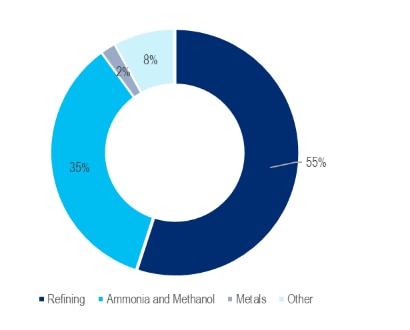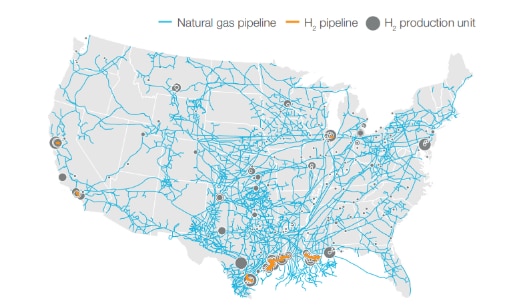
H2 has long been seen as the only alternative to cut carbon emissions in several hard-to-abate sectors. But higher costs, absence of incentives, and lack of urgency toward ESG goals led to lack of interest and progress. Until now, that is. This time looks different.
The Hydrogen Council says more than 1,000 H2 projects have been announced worldwide that will require investments of >$320B, a number that is increasing rapidly. Global demand for hydrogen, including from both fossil fuel and renewable sources, is expected to grow by ~3% YoY in 2023 to 79.5MMT. North America and China are responsible for around half each of total refining demand for hydrogen, which is expected to continue to grow.
Hydrogen Consumption in the US by End Market (2021)

© 2023 Citigroup Inc. No redistribution without Citigroup’s written permission.
Source: Citi Research, IHS Markit, and Department of Energy
Large-scale adoption far away — Citi Research analysts reckon large-scale adoption in mobility is 3-4 years away when H2 costs fall further and infrastructure is more built out. In the US, current delivered price of H2 is $10-12/kg, higher than ~$4-6/kg required for large-scale adoption in mobility. In addition, there are just 57 public H2 refueling stations in the United States. That is compared to 54k BEV charging stations and 145k ICE fueling stations. That said, hydrogen has several advantages over battery electric vehicles for long-haul applications. Refueling a truck may take ~20 minutes, whereas charging it would take several hours.
H2 in a flash — The most abundant chemical element in the universe has long been proposed as a low emission energy alternative. But actually extracting hydrogen can be energy intensive and pollutive in itself. Essentially, all production of hydrogen is from hydrocarbons via steam methane reforming (SMR), specifically from natural gas. Over the next decade, the challenge is how to effectively transport it at the scale and utilization required for end market plants.
Natural Gas vs. Hydrogen Pipelines

© 2023 Citigroup Inc. No redistribution without Citigroup’s written permission.
Source: Citi Research, Hydrogen Council
Large-scale investment would be required to meet this demand as the US has just ~0.1MMT of hydrogen liquefaction capacity currently compared ~10MMT of total annual hydrogen production. For transport applications, Citi Research analysts see parallels to the early rollout of EV charging stations, but the relatively low number of existing and proposed hydrogen retail refueling stations creates a chicken or egg dynamic, they say. This view, they say, is further tempered by the growing pains EV charging has faced.
Green hydrogen is produced via renewables sources such as wind and solar via electrolysis. Blue hydrogen pairs hydrogen made from fossil fuels with carbon capture and storage, reducing emissions of so-called grey hydrogen.
Wider adoption far off — Hydrogen’s most compelling use case is in hard-to-decarbonize industries -- those in which electrification isn’t feasible -- but lower prices are needed for wider green hydrogen to take off. Current production costs are $3-6/kg, but delivery and dispensing costs can be ~$10/kg if being transported by liquid tankers or tube trailers. Limited pipeline infrastructure for H2 means transporting it like natural gas is not yet practical.
Production tax incentives improve blue and green economics — Production tax credits of up to $3/kg under 45V make the US the most supportive country for hydrogen development globally.
Guidance is yet to be issued by the Treasury, however, which will determine how emissions of electrolysis hydrogen is calculated.
The full report goes into greater depth into the basic processes around hydrogen extraction and refinement and also at some of the drivers of adoption, including medium- and heavy-duty vehicles.
For more information on this subject, if you are a Velocity Subscriber please see North America Alternative Energy Equipment & Services - Hydrogen Hype: Same Same, But Very Different, published on 5 July 2023.
Citi Global Insights (CGI) is Citi’s premier non-independent thought leadership curation. It is not investment research; however, it may contain thematic content previously expressed in an Independent Research report. For the full CGI disclosure, click here.